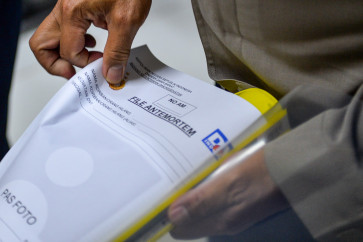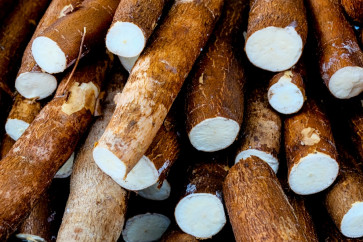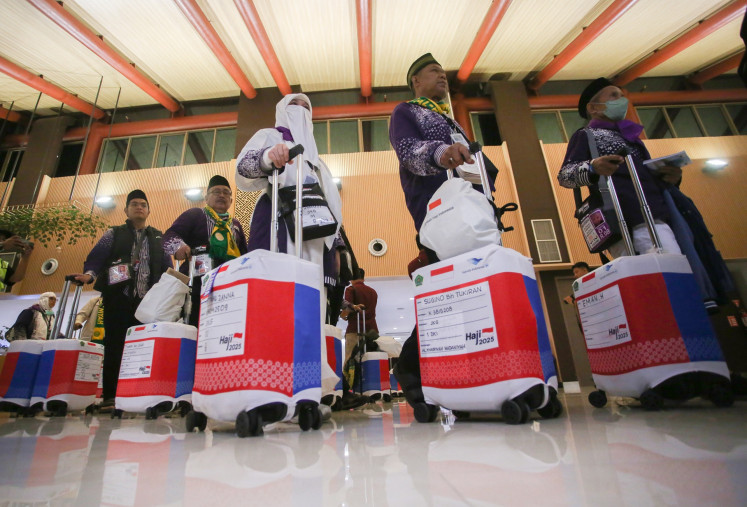A very Batak batik
Cross-cultural: A shirt made using Javanese batik techniques and patterns inspired by a Batak ulos
Change text size
Gift Premium Articles
to Anyone

Cross-cultural: A shirt made using Javanese batik techniques and patterns inspired by a Batak ulos.
'The best-known fabric from North Sumatra is the ulos,' says Rohayat Edy Gunawan, referring to the traditional woven textile of the province's large indigenous Batak community. 'Since batik has become better known recently, I thought why doesn't Medan have its own batik?'
The Sumatran-born Javanese is a creative entrepreneur. After completing a class in making batik sponsored by the local industry office, Edy wanted to develop a version of the textile that was unique to Medan.
So, he began collecting samples of the decorative motifs used by the different ethnic groups in North Sumatra, creating his Hari Hara Sundung on the Sky motif batik based on Toba Batak patterns and his Pani Patunda motif based on Simalungun Batak designs and a saddle-horse motif based on Melayu Deli fabrics.
Since Edy's creations combines motifs from several different ethnic groups, he decided to call his business Batik Motif Medan. 'The motifs we explore do not only focus on one ethnicity.'

Reds, blacks, yellows and greens are prominent in Edy's batik, reflecting the colors favored by the province's Batak and Melayu peoples. However, he said that he was happy to use any color desired by his customers.
Production is done in house. 'It's kind of a home industry,' said Edy. He has recruited about 10 people as batik makers, all of whom have gone through the same training course from the city. Out of his home in Medan Tembung Edy produces Medan-style batik that is hand-drawn (batik tulis) and printed by stencil (batik cap).
One of Batik Motif Medan's batik makers, Suryani, said that she has been working for Edy for 4 years.
'I was one of the first to join.'
The former housewife said that Medan-style batik was made not too differently from its Javanese counterpart. Several workers would labor over a single piece of hand-drawn batik that typically measures 2.5 by 1.3 meters, drawing patterns with a canting tool to apply wax. It takes three workers about two weeks to make a single large piece of batik, Suryani said. For a piece of batik cloth that using this technique can usually be completed within two weeks with three workers and sold for about Rp 300,000 (US$29.7). Stenciled batik based on traditional Batak patterns was easier to make, in comparison, and the workers could make up to 20 pieces a day, each of which could be sold for about Rp 150,000.

Edy says that he can make upwards of Rp 40 million a month. 'It's due to the government's good response to us. They help promote Batik Medan to be used as office uniforms.' He says that the firm's customers principally comprise government agencies, such as the provincial health department and the North Sumatra governor's office.
However, Edy said that booking several government contracts did not mean that Batik Motif Medan had no problems. Quite the contrary: He's been overwhelmed by the number because of the high number of requests made Edy feel overwhelmed.
'In Indonesia, there are only three places that are now producing Medan batik. There are [also] Pelopor Jaya in Menteng, Medan; and Batik Sumut on Jl. Letda Sujono, Medan,' said Edy. 'But the number of employees is not quite equal to the big number of requests.'
To overcome the shortage of trained batik makers, Edy said that he frequently held training in collaboration with the provincial trade office. 'But it's been less successful. For example, if there are 80 people in training, only 20 or so filter through. It can't be guaranteed.'
Cultural issues may be at the root of his labor problems, Edy said. The Batak people of North Sumatra are said to be less patient than Javanese, who have been accustomed to making batik since childhood, for example.

Suryani agreed. The batik maker, who specializes in dyeing fabric, said that she found it quite difficult to make batik in the beginning. 'For the coloring process, I had to memorize how to make a special concoction from chemicals such as naaptol or mercury,' said Suryani. 'Oh, there's a pungent smell when the wax is melted! Not everyone from North Sumatera can stand the smell.'
She said that she can make over Rp 1 million a month as a batik maker, although she regretted that there were not enough people to keep up with the orders. 'Other than a salary that is not too bad, the makers of Medan-style batik could also help promote the culture of the province,' Suryani said.
Edy says that he would like to make North Sumatra a tourist destination for batik hunters. 'If possible, the presence of Medan-style batik can make people around the world interested in collecting more than just batik from Solo [Surakarta], Jogja or Java.'
He is working on more ideas about merging Batak ulos with batik that he hopes can go international. 'They will be released in August,' said Edy.

' Photos by Aulia Adam and Antara









